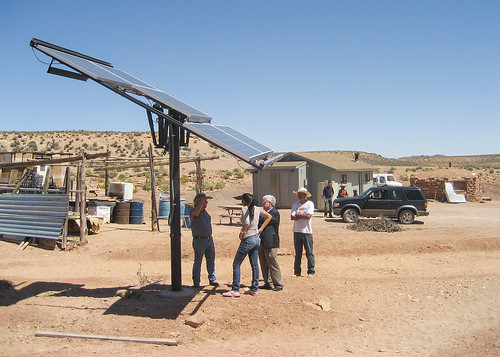
Betty and Kee Acothley live miles off the beaten track in the former Bennett Freeze area on the Navajo Nation.
Kee once tended thousands of head of sheep at the remote sheep camp he and his wife Betty call home. Now, at 80, he keeps only around 70 head. He and Betty, 79, follow the sheep on foot every day, returning to their modest home before dusk.
The Acothley still have to regularly make the one-hour drive along rough roads to fill their water tank, then the hour drive back to empty the water into their cistern, a rugged life for folks well into their golden years.
The “freeze” was imposed by former U.S. Commissioner of Indian Affairs Robert Bennett in 1966 as a way to settle a land dispute between the Navajo and Hopi people. It prohibited all development in the 700,000 acres of disputed land in the region. About 8,000 Navajos living in the area were prevented from building new homes, improving roads and infrastructure or making any improvements on their existing homes.
Although the tribes reached a settlement agreement in 2006, the “freeze” was not officially removed from the books until legislation, sponsored by U.S. Representative Ann Kirkpatrick, was passed and then signed by President Obama in 2009.
The Acothley home started out as more of a shed than a house. After 1966 they were not able to do any repairs or upgrades. Forty plus years in a harsh climate with no repairs took a toll on all of the homes within the Bennett Freeze area, including the Acothley’s. A Bureau of Indian Affairs study from that time found that over 75 percent of the homes in the area were unfit for habitation.
Once the freeze was lifted, the Acothley family qualified for a USDA Rural Development home improvement grant/loan combo. The Grand Canyon Trust added $15,000 of Renewable Energy Investment Funds to USDA’s $7,500 grant to bring electricity into the home. A water pump, run off the new electrical system, also means indoor running water for the Acothleys. For the first time ever, Kee and Betty were able to have lights, a coffee maker and even a television. In the winter they are able to plug in a small heater to take the chill off their home. A summer cooling system was also part of the package.
A 1 percent USDA loan to the Acothleys was used for a new floor, doors, siding, windows, insulation, weatherization and new shingles for their roof.
USDA Rural Development Arizona State Director Alan Stephens and Area Specialist Freddie Hatathlie recently presented the Acothleys with the 2013 Arizona Homeownership Month commendation during a visit to their home. Roger Clark with Grand Canyon Trust was there to congratulate them as well. Kee and Betty expressed their gratitude and pleasure with the repairs and rehabilitation that gives them a safer, more comfortable home.
To find out more about USDA home repair grant and loan opportunities, click here.

